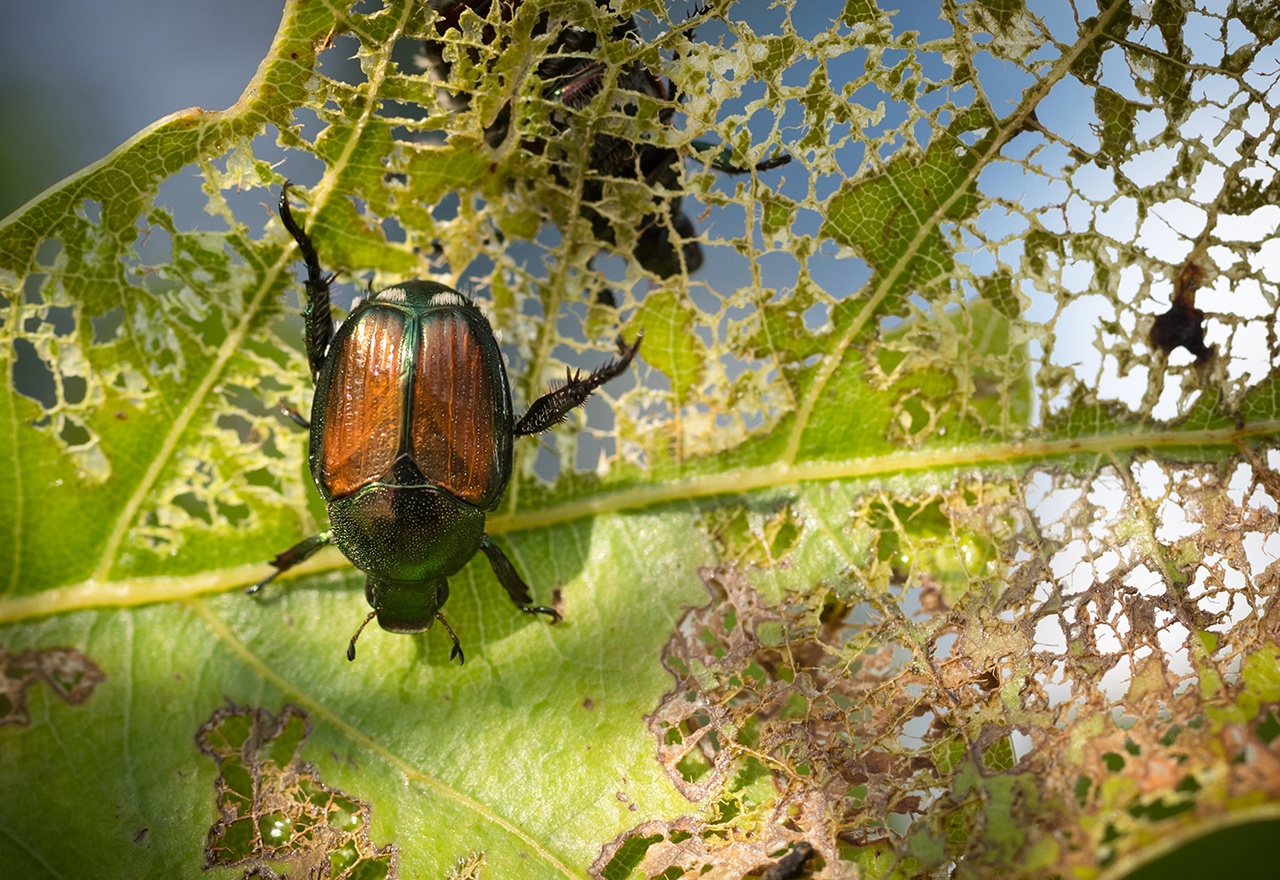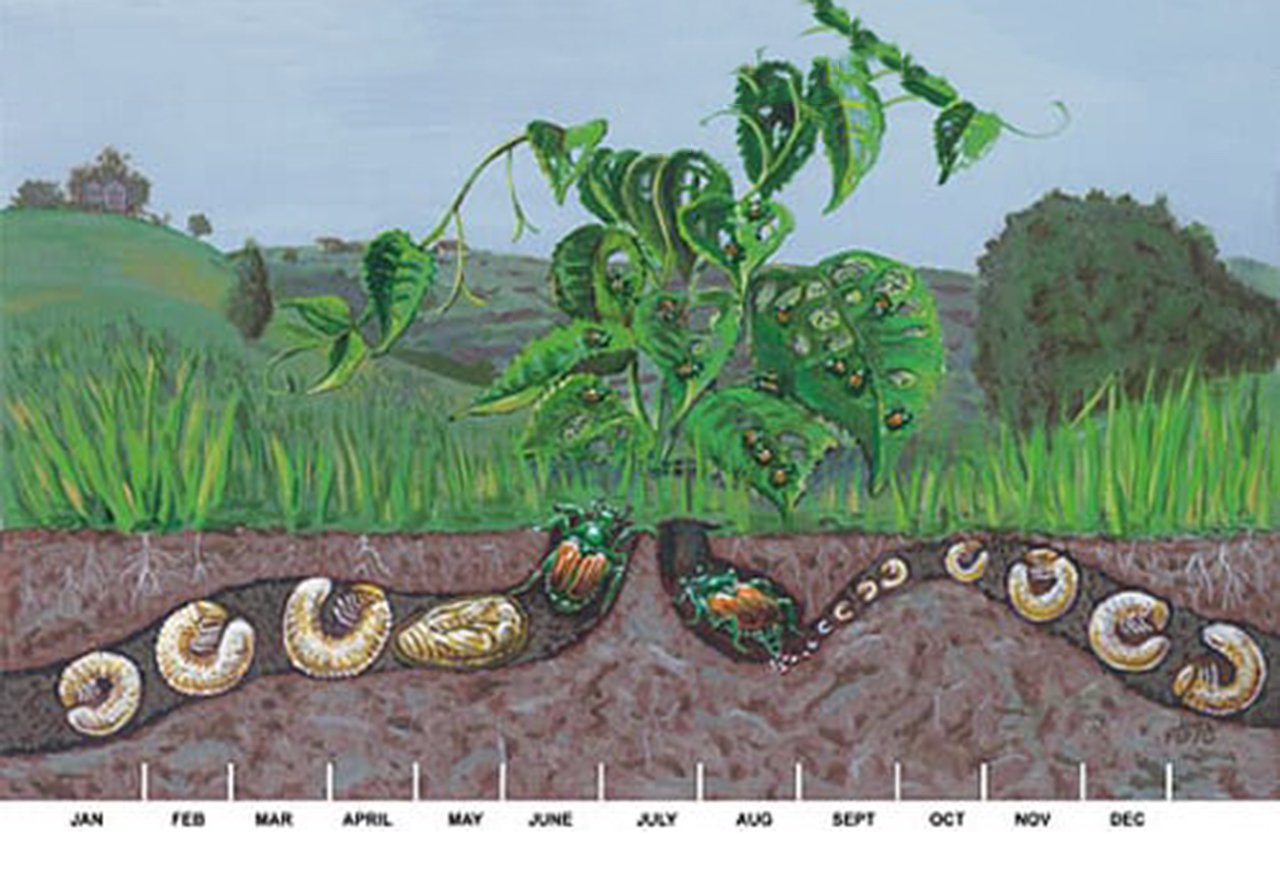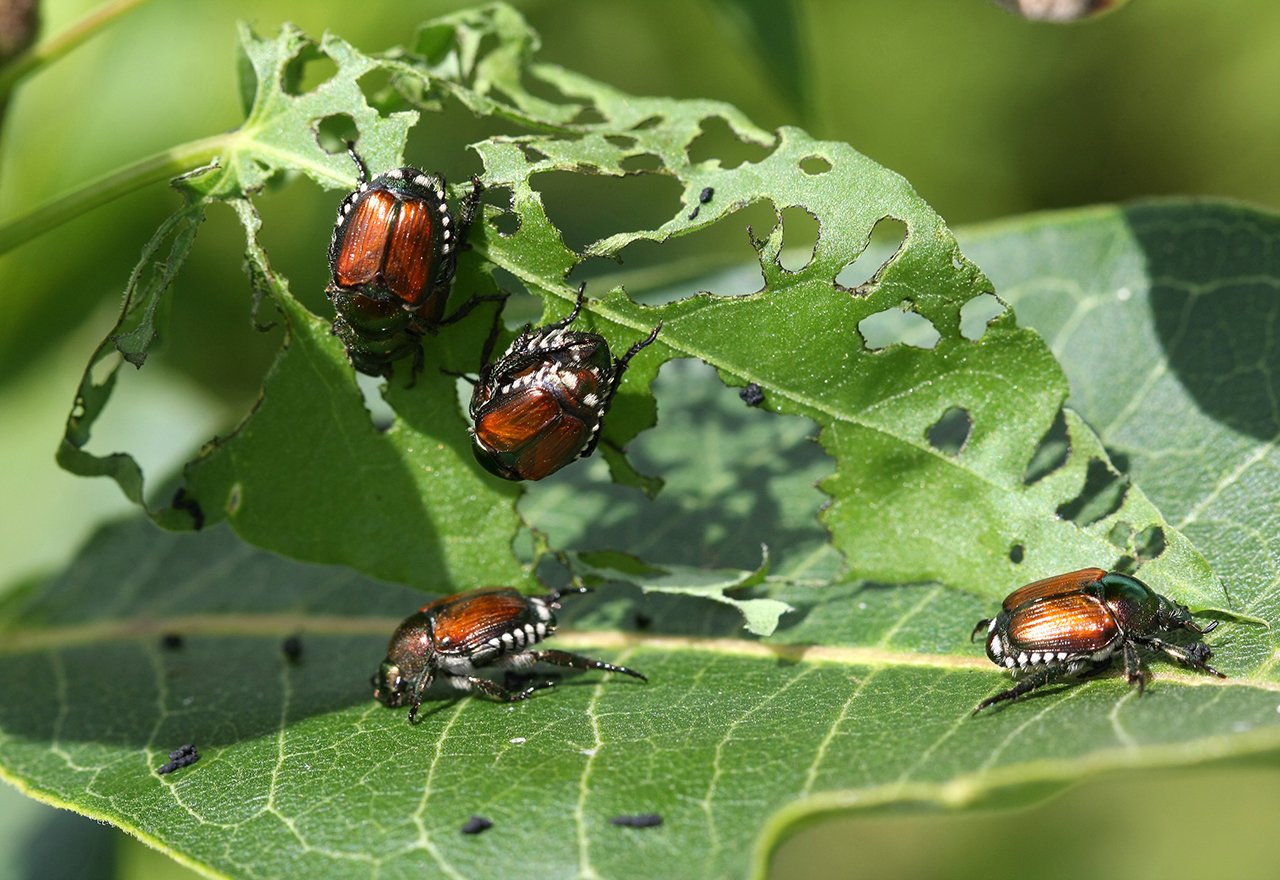One of the Most Devastating Pests to Urban Landscaping Plants

Japanese Beetles (Popillia japonica) are invasive species originally from Japan where they cause little damage. They were discovered in New Jersey in 1916 where they were accidentally introduced and have since spread to much of the United States, moving westward. They have no effective natural enemies in the States, and therefore thrive in the Midwest, as far west as the north-south line from Minnesota down to Arkansas, and every state east of the Mississippi River, except Florida.
Like many insects, Japanese Beetles change a great deal through their life cycle. Thankfully, they only have one generation per year. Eggs are small and white and generally laid in the soil within grassy areas in July or August. A single female can lay up to 60 eggs per year, averaging a few each day. Eggs hatch up to two weeks later depending on the temperature, and the larvae feed on roots in their direct vicinity. Three different instars grow and tunnel through the soil, often harming grass roots (especially Kentucky Bluegrass, Perennial Ryegrass, Tall Fescue, and Bentgrass), along with the roots of other plants. The last, chubby instar are usually referred to as white grubs, which can be very damaging to lawns. The instars do not all reach the same maturity level by the end of the Summer, but all hibernate in the soil over Winter, four to eight inches deep. In mid-April, or when temperatures are in the 60s, grubs are active again and actively feed in the soil. Grubs grow into pupae and then beetles. Adult Japanese Beetles emerge from the soil at the end of June into July, depending on the climate, location, and maturity.

Adults are about ⅗ of an inch long and have a metallic green body with copper-colored wing covers. Their antennae are club-shaped and their six legs and feet are black. They have white hair tufts on their sides and on their posteriors. Grubs are white and C-shaped with a darker head and distinct front legs. Japanese Beetle grubs look very similar to other insect instars and can only be positively identified by V-shaped series of hairs, which are not easy to see without very close inspection.
A large invasion of Japanese Beetles can be one of the most devastating events of urban landscape in the eastern United States. The beetles feed on around 400 different species of plants and are “skeletonizers.” This means they don't disturb the stalks and veins of leaves, but eat everything in between, causing the leaves to look like lace. They also feed on flowers and fruit. If just a few leaves are eaten, plants will survive but if most of a plant’s leaves are skeletonized, the plant often dies.
Adult beetles are usually active for six to eight weeks. Sometimes they form large masses, clumping together to feed or mate.
Japanese Beetles can fly up to a mile away to feed on a favorite plant. Healthy lawns all have some immature insects living in the soil but more than six per square foot can start to cause damage to the grass. Grubs are also attracted to and prefer thick thatch.
Not every beetle grub in your soil is a Japanese Beetle. They can be hard to identify from others such as Masked Chafer grubs or, European Chafer grubs.
Reducing Japanese Beetle grubs in your yard will theoretically reduce the number of adult beetles that feed on your plants, but it will not fully eliminate them. Our treatments do not get rid of all grubs, and it's important to note that adult beetles can fly from other areas and damage your plants.

We recommend a two-pronged approach when addressing Japanese Beetles in your lawn that will treat both grubs and adults: Neem Oil and Beneficial Nematodes.
Neem Oil is a natural suppressant of both Japanese Beetles and their larvae, grubs. This is our favorite all-purpose insecticide, miticide, and fungicide for organic gardening and lawn care. Neem Oil is derived from the Neem seeds and is not harmful to waterways. It kills all life stages of insects: eggs, larvae, and adults. Spray Neem Oil on both your lawn and your garden plants to get rid of grubs and Japanese Beetles. These treatments are safe for pollinators and are fast-acting. Neem Oil will help deter adults from laying eggs in your lawn as well.
We also offer an Organic Grub Control Lawn Treatment using Nematodes. These small organisms benefit your soil and feed on grubs. We’ve seen up to a 65% reduction of grubs when using this treatment. You can also go the DIY route and use the Nematodes we sell in our online shop. Nematode application will not be as fast-acting as Neem Oil, but it will have lasting effects and help protect your lawn from future infestations.
Trapping can seem like a great method for getting rid of beetles. Traps that are most widely available come in the form of a cloth bag or plastic tube baited with female Japanese Beetle pheromones and floral scents. These traps are very effective in catching beetles, however they usually attract more beetles to the area that would not have been there otherwise. Beetles then frequently feed on nearby leaves before getting trapped. We do not recommend this method.
Grubs thrive in damp lawns with a lot of thatch. To avoid creating these conditions where you live, we suggest you water infrequently, once a week, and water deeply, an inch at a time. This will ensure that your lawn is hydrated and green, but not damp or soggy. Aerate your soil to remove thatch. We recommend a Core Aeration in the Fall with a microbial decomposition enhancer, such as Thatch Master.
We can’t say this enough: healthy grass is the best prevention of weeds or invasive insects. Healthy grass has deep roots, which means it’s taller than you may be used to. Mow high: three and a half to four inches. Be sure your mower blade is share so you’re not ripping and damaging the grass, when you cut it. We also encourage you to let your grass clippings act as a fertilizer for your lawn, don’t bag them up. We also like to fertilize lawns twice in the Spring and twice in the Fall. Lastly, we recommend bi-annual aeration to loosen soil and reduce thatch: Core Aeration in the Fall and Liquid Aeration in the Spring or Summer. We can help with Organic Lawn Care Services or we also sell products in our online store to help you do it yourself.
There are a few beetles that look a lot like Japanese Beetles. False Japanese Beetles (Strigoderma arbicola) are very similarly sized and have a similar life cycle. However, they do not cause as much damage, do not have the white hair tufts on their ends, and their wing covers are brown, not copper. Rose Chafers (Macrodactylus subspinosus) are a very similar shape but are larger, a darker brown, and do not have any white hairs at all. Rose Chafers also usually make more irregular holes and do not eat an entire leaf at once.
